“No, You Can’t ‘Borrow’ a Bindi: A Drama-Filled Dive into Cultural Appropriation”
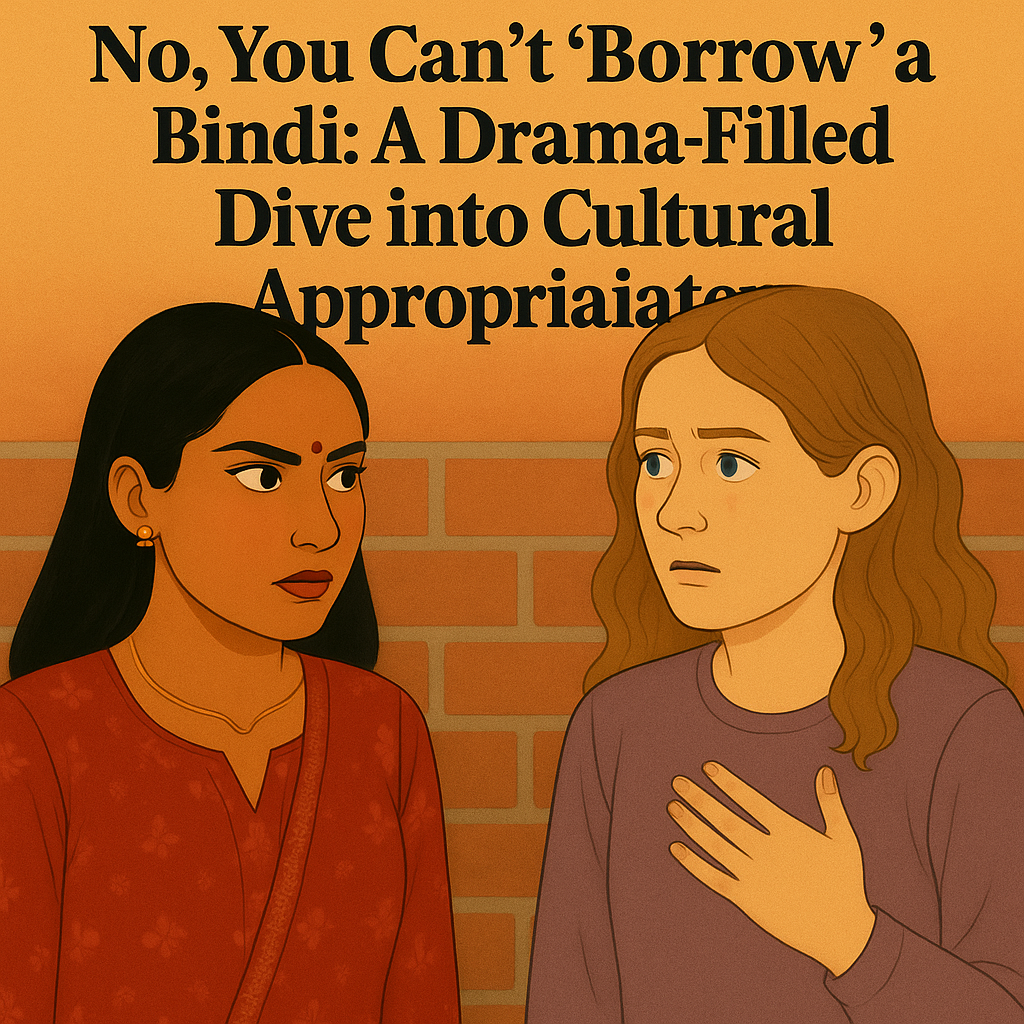
Welcome to the Culture Circus: Where Everything
Sacred Becomes Aesthetic
Western narratives seem obsessed with the “lost woman
finds meaning in the East” trope, as if something like
‘eEnlightenment is a gift you pick up next to a scented
candle at the gift shop.
● The heavily diluted Zen aesthetics and yogic wisdom
became the ‘peaceful vibes’ stripped of all their roots.
● Spoiler: A bindi doesn’t transform one’s spiritual
evolution—it just marks you as an aesthetic that is
disconnected from everything meaningful.
● What remains is an Instagrammable version of something
sacred and significant after sacred motifs are dragged to
festivals and masqueraded as “edgy accessories.”
● No, being clad in a sari and wearing henna for the feed
does not mean you “understand the culture.” It means you
bypassed the journey and took the tourist shortcut
through someone else’s identity for ‘likes’, pretending to be
curated.
● That flower crown? It’s not only “appreciation.” It’s time to
ask: Are you celebrating the culture or using it as an
accessory?
1. “It’s Just a Look!”—Said Every Culture Thief Ever🧷
What Is Cultural Appropriation? (Spoiler: It’s Not Borrowing, It’s Bulldozing)
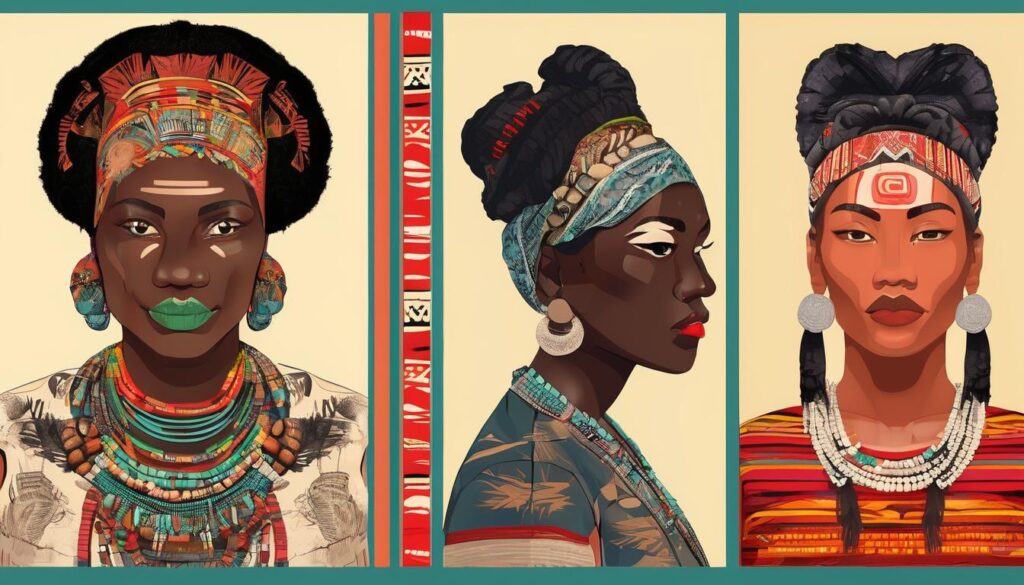
● You can borrow a sweater, but not lose thousands of years of
identity for an outfit’s social media post.
● Dominant groups exploit sacred aspects of marginalized
cultures for aesthetics, profit, or clout. That underlies cultural
appropriation, where original communities are excluded or
shamed for the same elements.
● “No, it’s not ‘inspiration’, it’s erasure, served with a filter and
#blessed in caption.”
● Reserving the term ‘appreciation’ requires context, credit, and
respect, which appropriation directly skips, heading straight to
the cart.
● To note the difference, ask yourself: Would I still we to if I
had to de wi te dirat ti every day?
1. The Runway Robbery: How Fashion Pillaged Identity
for Aesthetic Points
“Inspired” to Insensitive: When Fashion Crosses the Line
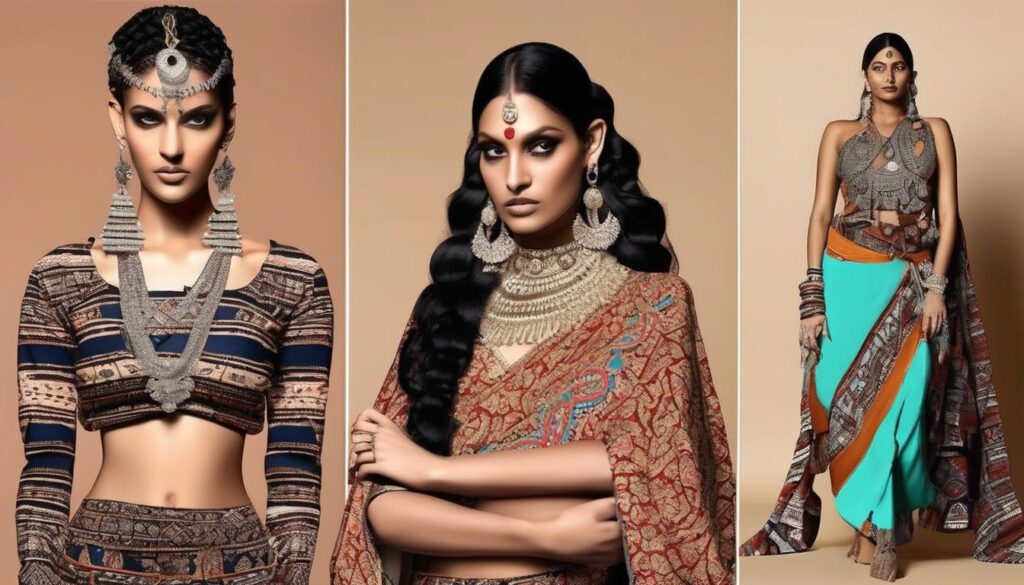
● Sacred symbols are more than mere decorations—they
have meaning, history, and deep cultural roots.
● In the fashion industry, symbols of this nature are treated
as props, something to be selected purely for “aesthetic”
reasons.
● Think of feathered headdresses on runway shows, bindis
worn as face gems, or dresses made from traditional
cloths worn to festivals.
● Rather than being celebrated, these elements are devoid
of context and commodified for social relevance.
● So the problem? These cultures are often still
marginalized or looked down upon, while the fashion
industry has no qualms about looking to them for
inspiration.
● Drawing inspiration from cultures isn’t inherently
bad; however, doing so without permission, tact,
understanding, or due credit. Is that feels less like style
and more like premeditated theft.
2.📺 Pop Culture’s Gold Medal in Appropriation: Welcome
to the Olympics of Oenone
Music, Makeup, and Misuse — How Celebs Made Culture Their Costume
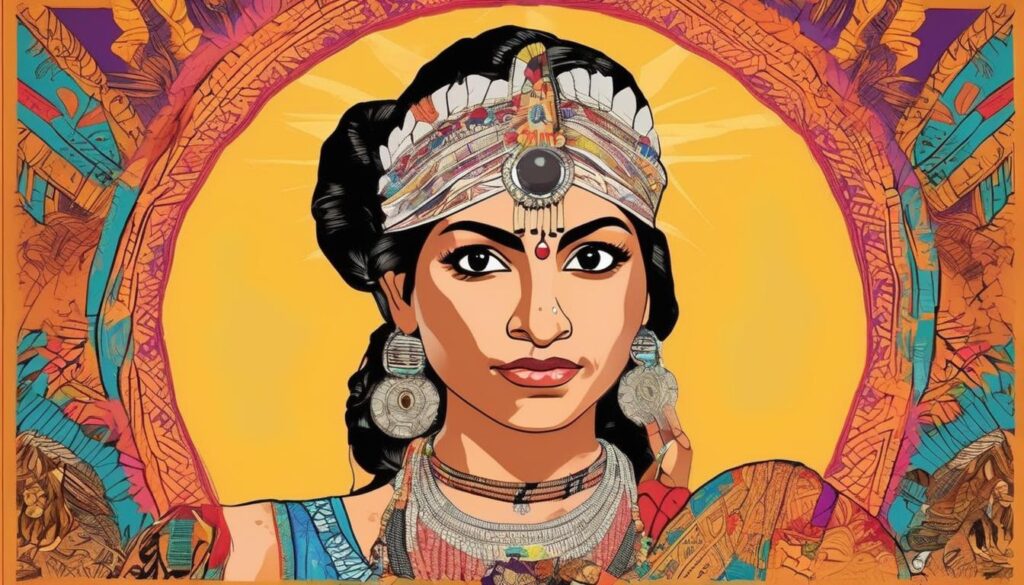
Pop culture isn’t just taking something; it’s filtering, taking, and
profiting from it.
● Looks and embellishments like ‘festival henna’ or ‘edgy’
traditional hairstyles seek to differentiate one from the
ordinary, not understanding.
● Cultural appropriation runs rampant in contemporary music,
award shows, and even the fashion industry, where emblems
of culture are transformed into add-ons.
● Imagine traditional dances turned into crude duels or religious
icons twisted into tasteless accessories worn for the shock
factor.
● These trends are termed ‘iconic’ as long as they are worn by
the rich and famous, but they are termed ‘ghetto’ or
‘unprofessional’ when worn by casual wearers from the actual
owning culture.
● In short, as long as it is misconstrued and looks trendy, it is
fashionable. But once misunderstood, branded as ridiculous.
3.🤡 “But I Appreciate It!” — Bless Your Misguided Heart
Appreciation vs. Appropriation: A Very Confused Quiz
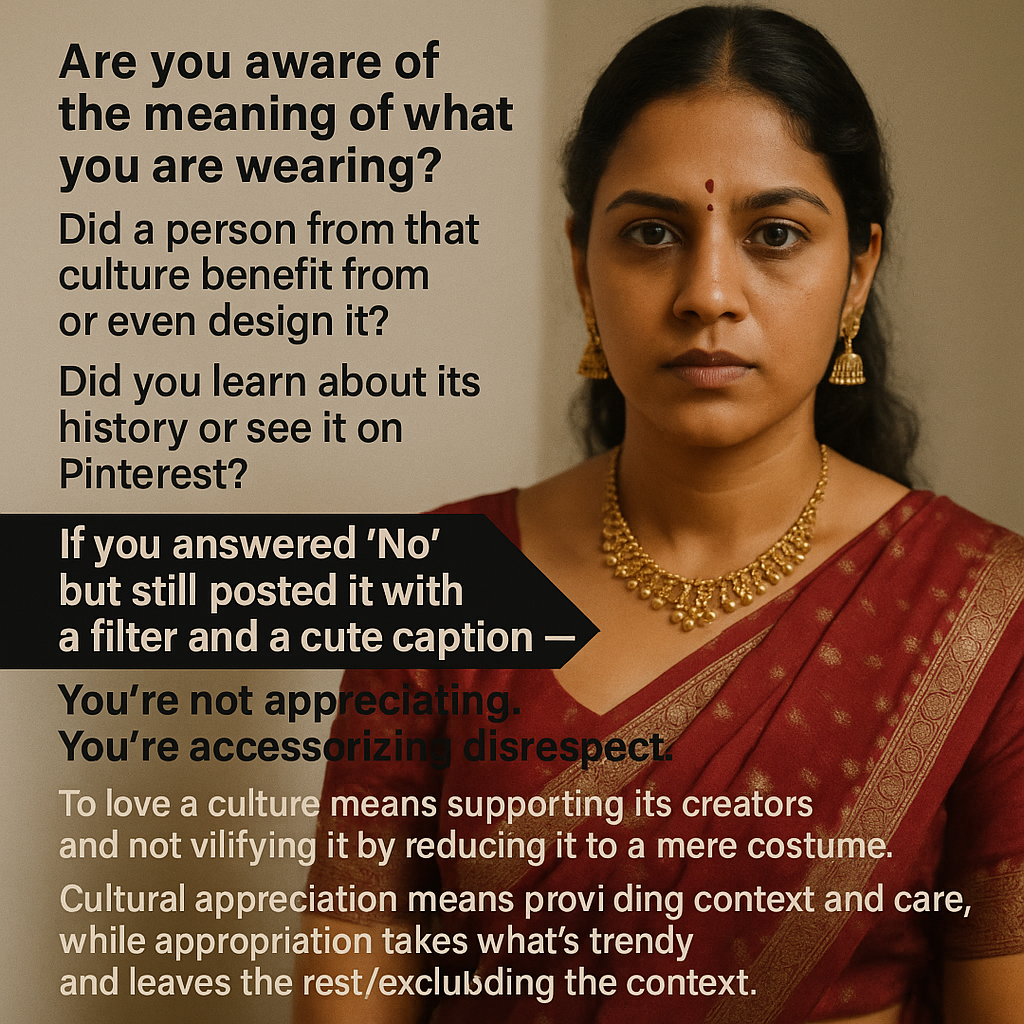
● Are you aware of the meaning of what you are wearing?
● Did a person from that culture benefit from or even design it?
● Did you learn about its history or see it on Pinterest?
● If you answered “No” but still posted it with a filter and a cute
caption —
➤ You’re not appreciating. You’re accessorizing
disrespect.
● To love a culture means supporting its creators and not
vilifying it by reducing it to a mere costume.
● Cultural appreciation means providing context and care, while
appropriation takes what’s trendy and leaves the
rest/excluding the context.
4.🧠 How to Appreciate Without Colonizing the Vibe
Don’t Be That Girl (or Guy): Tips That Won’t Get You Canceled
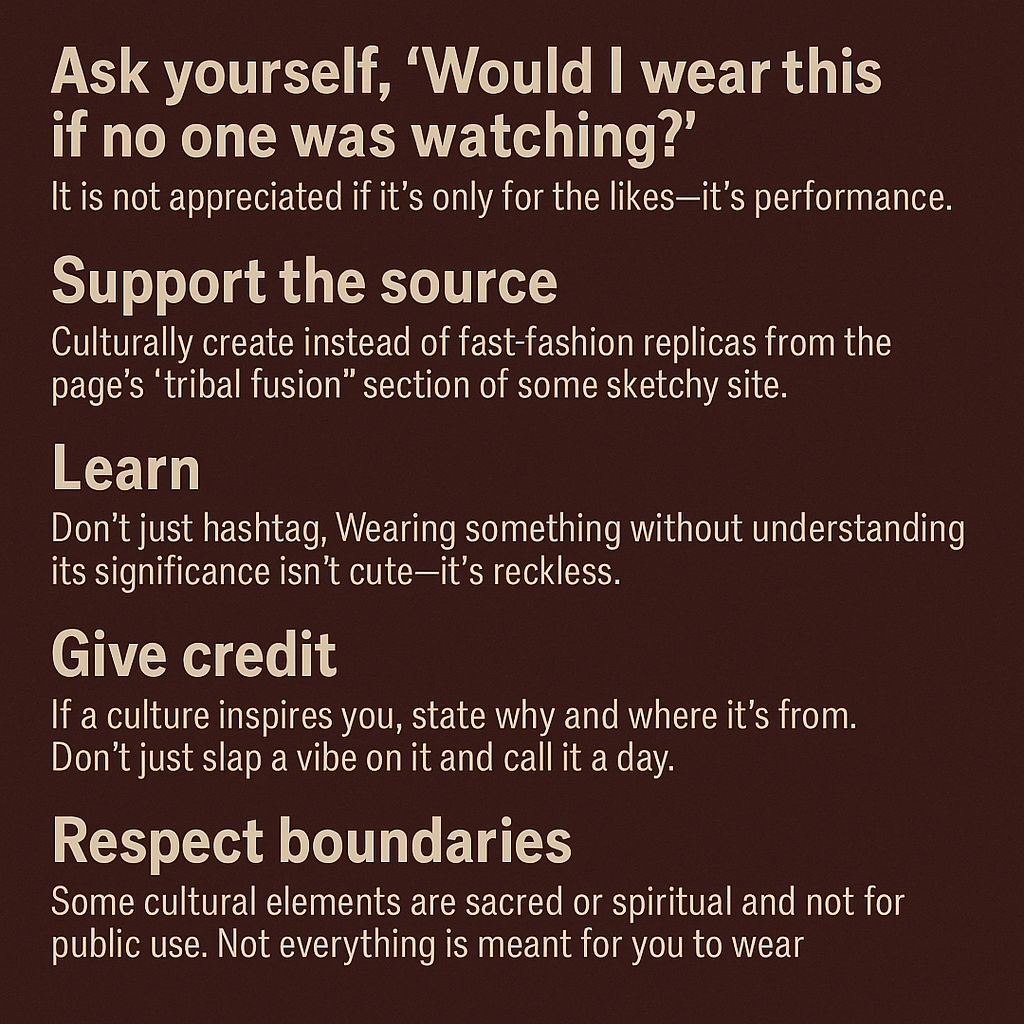
Ask yourself, “Would I wear this if no one were watching?” It is not
appreciated if it’s only for the likes—it’s performance.
● Support the source: Culturally Create instead of fast fashion
replicas from the page’s “tribal fusion” section of some sketchy
site.
● Learn: Don’t just hashtag. Wearing something without
understanding its significance isn’t cute—it’s reckless.
● Give credit: If a culture inspires you, state why and where it’s
from. Don’t just slap a vibe on it and call it a day.
● Respect boundaries: Some cultural elements are sacred or
spiritual and not for public use. Not everything is meant for
you to wear.
5.🌴🎧😬 Coachella or Culture Crime Scene?
Your Glitter Isn’t Enlightenment — It’s Just Glitter
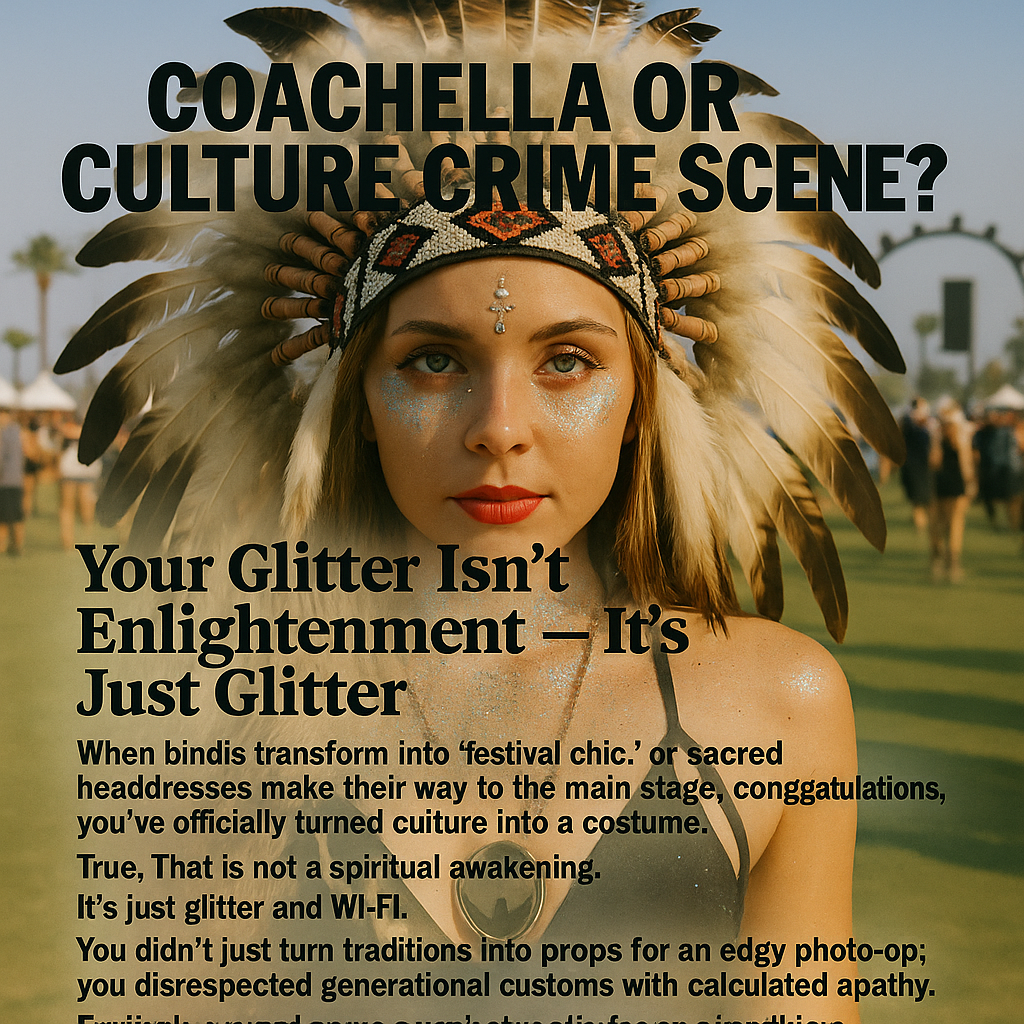
● When bindis transform into “festival chic,” or sacred
headdresses make their way to the main stage,
congratulations, you’ve officially turned culture into a
costume.
● True, that is not a spiritual awakening. It’s just glitter and
Wi-Fi.
● You didn’t just turn traditions into props for an edgy
photo-op; you disrespected generational customs with
calculated apathy.
● Festivals are not some permission slip for wearing things
that ‘look exotic.’
● A vibe with someone else’s culture, but none of the
history is a vibe. That’s a violation.
6. Insta-Famous, Context-Absent: The Influencer
Insensitivity Epidemic
Henna Isn’t a Tattoo. Saris Aren’t “Goddess Core.” And No, You’re Not
Enlightened
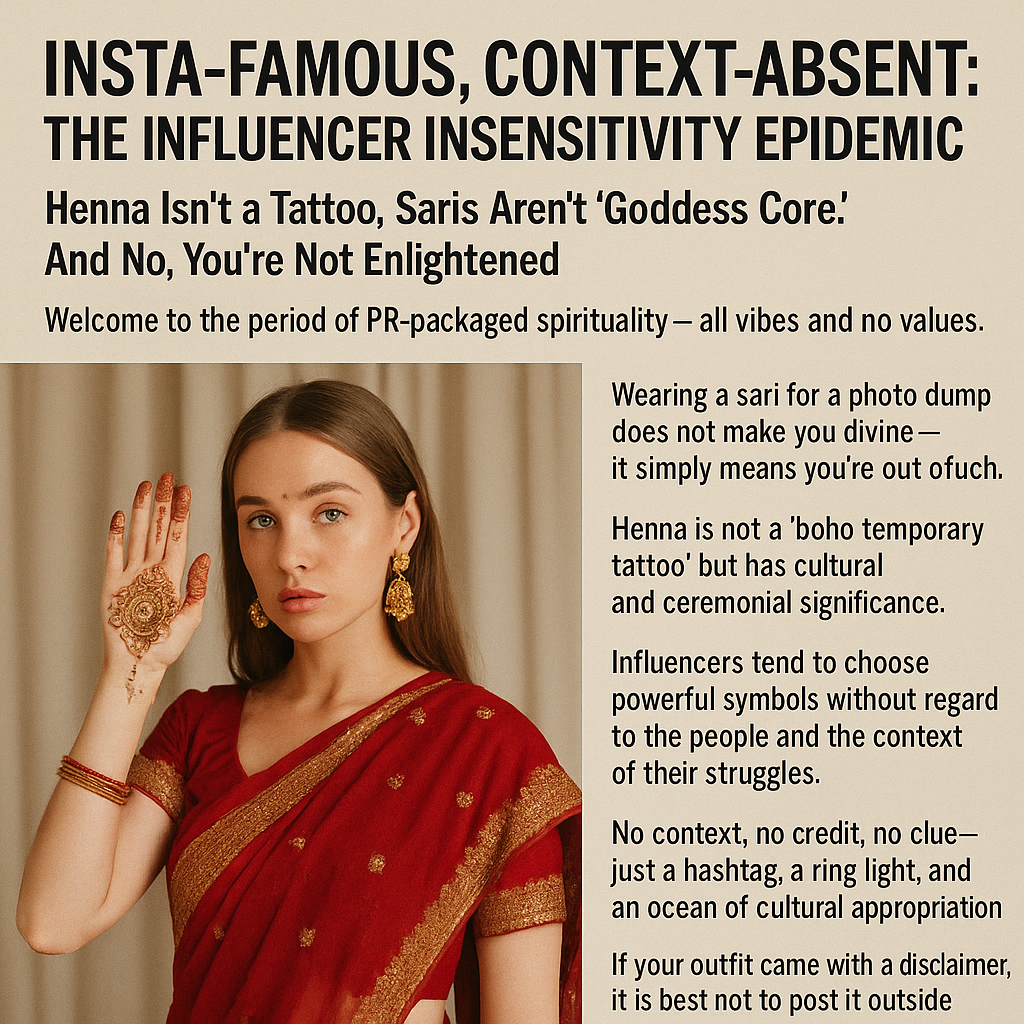
● Welcome to the period of PR-packaged spirituality — all
vibes and no values.
● Wearing a sari for a photo dump does not make you divine
— it simply means you’re out of touch.
● Henna is not a ‘boho temporary tattoo’ but has cultural
and ceremonial significance.
● Influencers tend to choose powerful symbols without
regard to the people and the context of their struggles.
● No context, no credit, no clue–just a hashtag, a ring light,
and an ocean of cultural appropriation.
● If your outfit came with a disclaimer, it is best not to post it outside.
7. Brands Gone Wild: Selling You Culture at $899 a Pop
From Sanskrit Sans Meaning to “Tribal” Jackets by People Named Brad
● When companies plaster sacred scripts on mats used for yoga
or manufacture ‘tribal’ jackets without any affiliation to the
culture, that goes beyond fashion and ventures into cosplay
capitalism.
● Using ancient cultures to market leggings, incense, or even
mindfulness, with no regard or respect for the people who
generated them, constitutes exploitation concealed in a price
tag.
● If no one from that culture was included in the design team,
Then it is definitely not ‘global inspiration.’
● If your advertising strategy lacks substance and is purely
aesthetic, congratulations — you have monetized
meaninglessness.
● Inclusion transcends simply printing Sanskrit onto a sports
bra. To be truly inclusive, one must actively engage with and
attend to the individuals who form the culture.
8. 📸🙄🔥 Influencers & Insta-Insensitivity
Culture Isn’t Just Content — But Try Telling That to the Explore Page
● The influencers are equipped with brand deals, ring lights,
and no context comprehension.
● Henna? Just a cool tattoo.
● Saris? Flowing goddess vibes.
● Captions? It is as if someone decided to perform an
unscrambled search on a peculiar quote about “finding
oneself.”
● When “cultural appropriation” becomes an #OOTD
opportunity, the essence vanishes, but the profit remains.
● People who get abandoned? The ones who exist in that
culture without the filters or followers.
9. 🛒💸📉 When Brands Go on a Cultural Shopping Spree
Cultural Chic, Corporate Cheap
● From butchered Sanskrit yoga lines to $800 ‘ethnic chic’
jackets, it’s capitalism in cultural cosplay.
● They’ll hire someone who genuinely understands them, but
won’t hire someone who understands them.
● It’s all participation, never profit.
● Appreciation doesn’t scale, but appropriation sure does.
Conclusion — Cute Outfit. But At What Cost?
● But only when it sells out fast: brands love diversity.
● From butchered Sanskrit yoga lines to $800 ‘ethnic chic’
jackets, it’s capitalism in cultural cosplay.
● They’ll hire someone who genuinely understands them, but
won’t hire someone who understands them.
● It’s all participation, never profit.
● It seems appreciation doesn’t scale, but appropriation sure
does.

